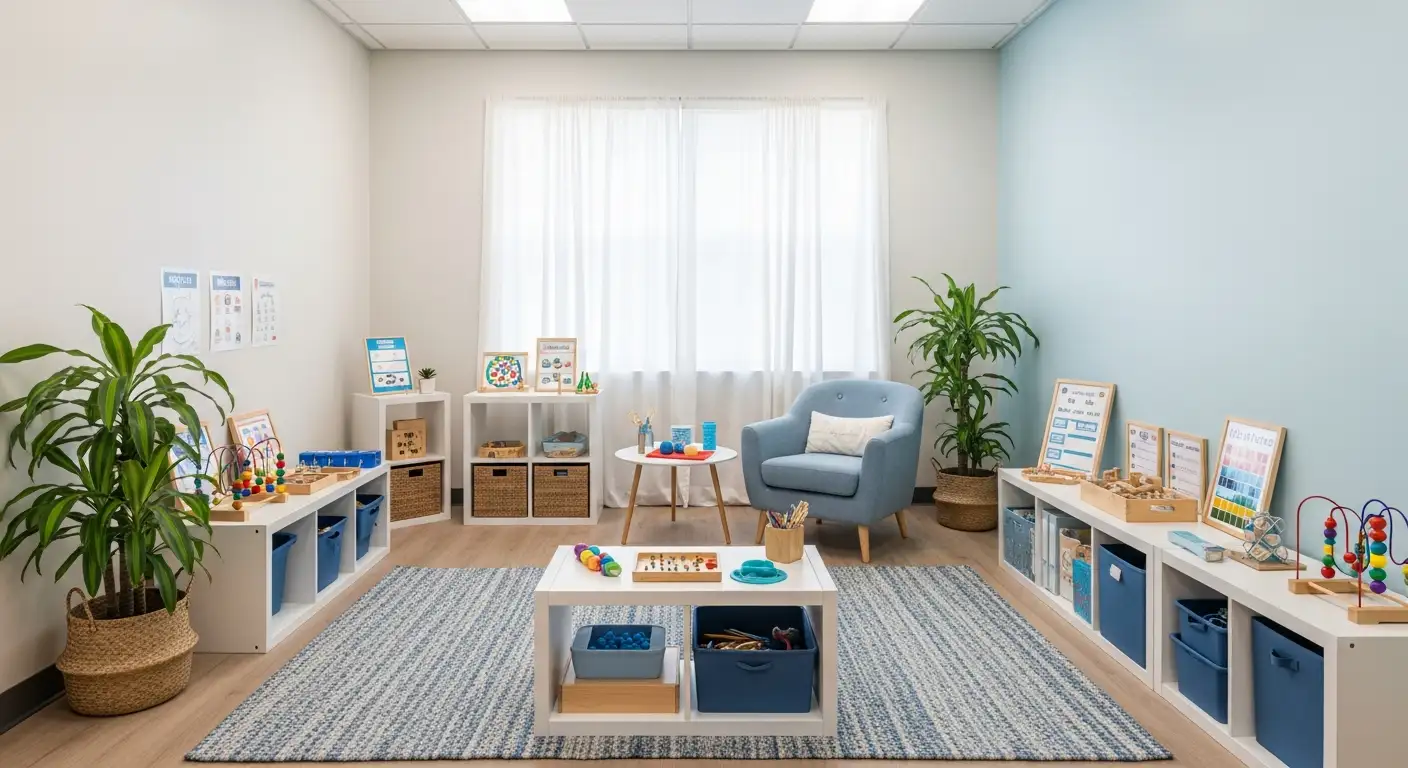The Importance of Establishing Routines in ABA Therapy

Understanding the Critical Role of Routines in ABA Therapy
Establishing consistent routines and structured schedules is fundamental in supporting individuals with autism spectrum disorder (ASD). These strategies create predictability, reduce anxiety, and foster independence, making daily life more manageable and promoting developmental progress. This article explores the importance of routines in ABA therapy, illustrating how they improve behavioral and learning outcomes for children with autism.
The Foundation of Routines in Autism Support

What is the importance of structures and routines for individuals on the autistic spectrum?
For individuals with autism, establishing regular routines and structured activities is fundamental to their well-being and development. These routines provide a sense of predictability and familiarity, which is crucial in reducing feelings of stress and anxiety that often accompany unpredictable environments or sudden changes.
Consistent routines help children and adults on the spectrum understand what to expect throughout their day, leading to improved behavior and emotional regulation. For example, visual supports like schedules and social stories prepare them for upcoming activities, easing transitions and fostering independence.
Additionally, structured routines serve as a foundation for reinforcing learning and new skills. When activities are repeated in the same order and at the same time each day, it helps reinforce understanding and retention. This consistency allows for better focus during tasks, promotes self-confidence, and encourages participation.
Caregivers and support systems—including professionals such as therapists—play a vital role in creating and maintaining these routines. Using tools like timers, visual cues, and positive reinforcement can further enhance adherence to routines.
It’s also important to introduce changes gradually and with support. Small, predictable adjustments help build adaptability without overwhelming the individual. Flexibility within routines allows for necessary variation, helping individuals manage stress and develop resilience.
In summary, predictable structures and routines are essential in supporting children and adults with autism. They foster a secure environment where individuals feel confident to explore, learn, and develop new skills, all while reducing the overwhelming effects of unpredictability.
Enhancing Daily Life Through Structured Routines
Why are routines important for children with autism?
For children with autism, routines serve as a fundamental part of daily life by providing essential structure and predictability. When routines are in place, children often feel more secure because they understand what to expect throughout the day. This sense of certainty can significantly reduce feelings of anxiety and stress linked to unpredictability and sudden changes.
Structured routines support children in developing independence as they learn to perform daily tasks, such as brushing teeth or preparing for bed, with minimal assistance. Repetitive activities within routines also create valuable opportunities for reinforcing communication and social skills, especially when children are encouraged to participate actively and positively.
Furthermore, routines enable children to better manage their emotions and behavior. For example, a consistent bedtime routine helps regulate sleep patterns, which are crucial for overall well-being. Visual supports like schedules and timers make transitions smoother, helping children adapt to daily changes more comfortably.
Overall, establishing predictable daily routines helps children with autism build confidence, foster emotional regulation, and promote ongoing learning and development. Support from caregivers and professionals, coupled with gradual introduction of routine elements, can enhance the benefits and ensure routines remain effective and engaging.
Visual Schedules and Effective Communication Strategies

Why are schedules important for autism?
Establishing routines and schedules is essential for individuals with autism because it provides clarity and predictability in their day-to-day life. Visual supports, such as visual schedules and social stories, help children understand what to expect and prepare for upcoming activities. Since many children on the spectrum process visual information more effectively than verbal instructions, these tools make daily tasks and transitions more accessible.
Visual schedules assist in reducing stress by laying out routines clearly, helping children anticipate changes and avoid confusion. They also support independence by enabling children to follow routines with minimal prompts, boosting their confidence and self-reliance.
Implementing schedules gradually, while involving the child in their creation, promotes a sense of control and engagement. When changes are necessary, using visual change cards or cues helps children adapt more smoothly, making transitions less overwhelming.
Overall, visual schedules serve not only to organize daily activities but also to foster inclusion and better behavior by creating predictable environments. This consistency is particularly beneficial for children with autism, as it supports their overall development and helps them navigate the world more comfortably.
Reducing Stress and Building Resilience

How do routines help autistic people cope with stress?
Routines and rituals are crucial tools for helping autistic individuals manage stress. By providing a predictable structure to daily life, routines reduce feelings of uncertainty and anxiety. When activities are consistent and familiar, they foster a sense of order that can be very comforting.
Engaging in habitual, repetitive activities—often called stimming—allows autistic people to self-soothe and maintain calmness. These behaviors might include movements like rocking or hand-flapping, and are often linked to routines and personal interests. Such behaviors serve as calming mechanisms that help regulate emotions.
Furthermore, focused interests or hobbies become safe outlets for relaxation and stress relief. These activities can boost mood and provide a sense of achievement, contributing to overall mental well-being.
By maintaining structured environments, individuals are better equipped to stay in control during stressful situations. The combination of predictability, familiar activities, and interests enhances emotional stability and resilience.
How does establishing a schedule help in emotional regulation?
Creating consistent routines supports emotional regulation by offering a sense of security and stability. Children and adults with autism can better manage their feelings when they know what to expect. Visual supports like schedules and social stories prepare them for upcoming events, reducing surprises that may trigger emotional distress.
Routines also foster independence, allowing individuals to learn and practice coping skills in a safe setting. When routine activities, such as bedtime or morning preparations, are well-established, they signal to the nervous system that it’s time to relax or get ready, aiding in emotional calmness.
Flexibility within routines allows for manageable adjustments, helping individuals learn resilience and adapt to changes gradually. This balance of stability and flexibility encourages emotional growth and reduces overwhelm.
Additional Strategies for Stress Management
Implementing routine activities alongside other supportive tools can further improve stress management in autism. Techniques like timers and visual cues help children see what’s coming next, reducing anxiety related to transitions.
Creating a calm, organized environment and involving caregivers in routine planning enhance consistency. Collaboration with therapists can assist in customizing routines to individual needs, ensuring they promote both comfort and development.
In summary, routines serve as a foundation for emotional stability and resilience in autism. They allow for predictable, safe environments that help manage stress, foster self-regulation, and promote overall well-being.
Structured Routines and Autism Developmental Outcomes

Why are schedules and routines important for autism?
Establishing a consistent routine provides a sense of predictability and security for individuals with autism. Using visual supports like visual schedules and timers, routines help clarify daily activities, making transitions smoother and reducing feelings of uncertainty. Since many people with autism process visual information more effectively than verbal instructions, these tools make understanding and anticipating events easier.
Creating structured routines can significantly lessen anxiety and improve behavior by helping individuals comprehend what to expect next. When routines incorporate familiar activities, they promote independence and confidence, making children more comfortable in their environment.
Involving the individual in setting up routines and gradually introducing changes allows for greater flexibility and adaptability. Visual cues such as change cards can prepare them for upcoming adjustments, easing transitions. Overall, routines support not just organization but also inclusion, enabling individuals with autism to navigate their daily lives with greater ease.
How do routines support learning and behavior?
Consistent routines bolster learning by establishing familiar frameworks where children can rehearse and strengthen their skills. For children on the autism spectrum, this repetition reinforces behavior and aids skill acquisition.
Routines make it easier for children to focus on tasks, as predictability reduces stress and distractions. Structured settings help children better understand expectations, leading to fewer behavioral challenges. For example, a well-established bedtime routine signals the body to prepare for sleep, improving sleep quality and overall well-being.
Regular routines across different days, including weekends, further support learning by maintaining consistency. This predictability enables children to generalize skills across various contexts.
How does this impact skill acquisition and generalization?
Creating routines aligned with a child's interests and strengths increases motivation and engagement. These routines offer ongoing opportunities to practice and refine skills, whether it’s brushing teeth, dressing, or social interactions.
Visual supports such as social stories and visual schedules help children anticipate upcoming activities and transitions, reducing anxiety. This preparation encourages gradual introduction of new activities, supported by positive reinforcement.
Furthermore, routines foster independence as children learn to complete tasks on their own, boosting self-esteem. The consistency allows skills learned in one setting to transfer to others, a process known as generalization.
Structured routines, especially when supported by professional therapies like ABA, occupational, and speech therapy, create an environment where children can thrive. They serve as both a foundation for learning and a tool for emotional regulation, making everyday life more manageable and promoting continuous development.
| Aspect | Description | Supporting Tools and Strategies |
|---|---|---|
| Visual supports | Help understand daily activities and anticipate transitions | Visual schedules, timers, social stories |
| Flexibility | Allows adaptation to individual needs and changing circumstances | Change cards, gradual activity introduction |
| Professional support | Enhances routine effectiveness and learning | ABA, occupational, speech therapies |
| Parental involvement | Encourages consistency and reinforces routines | Collaboration, positive reinforcement |
| Impact on behavior | Reduces anxiety and promotes emotional regulation | Clear signals, predictable schedule |
Establishing and maintaining structured routines plays a pivotal role in supporting the developmental journey of children with autism, laying the foundation for improved learning, behavior, and independence.
Creating Flexible Yet Consistent Routines
How do routines help autistic people cope with stress?
Routines and rituals are fundamental in helping autistic individuals manage stress. They create a predictable environment, which eases feelings of uncertainty and anxiety. When daily activities are structured, autistic people know what to expect, which provides a sense of stability and comfort. This predictability reduces the mental load of figuring out unfamiliar situations, thus lowering stress levels.
Familiar routines also support self-regulation by offering a reliable framework to engage in calming activities. Many autistic individuals use stimming—repetitive movements or sounds—to self-soothe and maintain composure, often triggered by routines or interests. These behaviors help them stay calm during overwhelming moments.
Additionally, focusing on hobbies or special interests within routines can serve as safe outlets for relaxation and enjoyment. These activities not only divert attention from stressful stimuli but also promote feelings of mastery and joy. Together, routines, stimming, and interests act as a comprehensive approach to stress management, helping autistic individuals feel more in control of their emotions and environment.
Balancing routine stability with adaptability
While routines provide numerous benefits, too rigid an approach can sometimes cause stress when unexpected changes occur. Therefore, introducing flexibility within routines is essential.
One way to foster balance is to keep the core structure of routines but allow small, predictable adjustments. For example, slightly changing the order of activities or the timing can help develop adaptability without disrupting the sense of security.
Using visual supports like social stories or visual schedules can prepare individuals for upcoming changes, making transitions smoother and less stressful.
Gradual introduction of new activities
When adding new activities, it’s important to do so gradually. Introducing changes slowly over time gives the individual a chance to adapt without feeling overwhelmed.
Positive reinforcement plays a crucial role here. Praising efforts and successes helps reinforce the new routines, encouraging engagement and reducing resistance.
Caregivers should observe the individual's responses closely and make adjustments as needed. Combining gradual steps with consistent cues and praise ensures new activities are integrated successfully.
Strategies for creating adaptable routines
| Strategy | Description | Benefits |
|---|---|---|
| Use Visual Schedules | Create visual timelines of daily routines | Helps anticipate changes and understand expectations |
| Incorporate Small Changes | Introduce minor adjustments gradually | Builds flexibility and resilience |
| Reinforce Positively | Use praise to encourage attempts at new activities | Promotes motivation and confidence |
| Communicate Clearly | Use social stories and clear cues | Minimizes confusion and anxiety |
| Collaborate with Professionals | Seek guidance from therapists | Ensures routines meet individual needs |
Creating routines that balance stability with flexibility, supported by gradual introduction and positive reinforcement, helps autistic individuals thrive. These strategies foster both confidence and adaptability, making everyday life more manageable and less stressful for children and adults alike.
Role of Caregivers and Professionals in Routine Implementation

Why are structures and routines crucial for individuals on the autistic spectrum?
Structures and routines are essential for people on the autism spectrum because they bring predictability and consistency into daily life. These elements help reduce feelings of stress and anxiety, offering a sense of security. When routines are stable, autistic individuals can focus better, manage transitions smoothly, and develop important skills like communication and independence.
Visual schedules, regular mealtimes, and consistent sleep routines are among the common strategies used to support this stability. Caregivers and support systems, including professionals, play a vital role in establishing and maintaining these routines. This team effort ensures that routines are tailored to individual preferences and needs.
Small, gradual changes within routines can help prevent distress. Supporting flexibility allows individuals to adapt slowly to new activities or schedules, fostering resilience. Overall, well-established routines boost confidence, emotional regulation, and the ability to handle daily challenges effectively.
Collaborative routine planning
Professionals like ABA therapists, occupational therapists, and speech therapists work closely with caregivers to create effective daily routines. They help identify key activities that promote learning and independence. Developing visual supports such as schedules, social stories, and timers is part of this planning process.
Engaging the individual in routine creation is also encouraged. When children or adults participate in planning, they tend to be more motivated and cooperative. Caregivers are advised to communicate openly with professionals to tweak routines as needed, ensuring continued relevance and effectiveness.
Using support tools and technology
Technology offers numerous tools to aid routine implementation. Visual schedules displayed on tablets or boards help individuals understand what’s next, reducing anxiety about upcoming activities.
Timers serve as visual cues to manage transitions smoothly, indicating when an activity is about to end. Apps designed for routine management can send reminders and provide visual or auditory signals to support independence.
Social stories prepare individuals for transitions or changes in routines, helping them process new situations calmly. These tools work together to promote consistency, support learning, and empower individuals with autism to thrive in everyday life.
Conclusion: Making Routines a Cornerstone of ABA Therapy
What is the importance of structures and routines for individuals on the autistic spectrum?
Structures and routines hold a foundational role in supporting individuals with autism. They offer predictability and consistency, which help reduce anxiety and foster a sense of security. When routines are established, children and adults on the spectrum can better manage daily transitions, learn new skills, and regulate their emotions.
Creating a predictable environment with visual schedules, regular mealtimes, and sleep routines allows individuals to understand what to expect next, minimizing stress and confusion. This clarity not only promotes comfort but also enhances their ability to focus and participate actively in daily activities.
Importantly, maintaining flexibility within these routines is essential. Small adjustments or gradual changes, supported by positive reinforcement, help build adaptability and prevent distress. Caregivers and professionals play a vital role in establishing and maintaining these structures, ensuring they align with each individual’s preferences and strengths.
Regular routines serve to boost independence, allowing individuals to learn and practice tasks autonomously. They also foster emotional regulation by providing a sense of control and stability, which can reduce challenging behaviors. Supportive tools such as visual supports and timers are especially effective in helping individuals anticipate and transition between activities smoothly.
In conclusion, routines act as a cornerstone in autism support, particularly within ABA therapy. They create a safe, predictable environment that promotes learning, reduces stress, and increases confidence—ultimately enabling individuals to navigate their daily lives more effectively.
Fostering Independence and Well-being Through Routine
Implementing structured routines as part of ABA therapy forms a cornerstone for supporting children with autism. When effectively established, routines reduce anxiety, improve behavioral outcomes, and support skill development, fostering a sense of security and independence. Caregivers and professionals should work together to craft routines tailored to individual needs, incorporating visual supports and flexible adaptations. By doing so, we create a nurturing environment that promotes growth, confidence, and overall well-being, significantly enhancing the quality of life for individuals on the spectrum.
References
- Importance of Routine in Autism: A Key to Stability | Move Up ABA |
- The Importance of Routine in Autism Care - All Star ABA
- Importance of Routines - PediaPlex
- 12 Benefits of Predictable Routines for Kids with Autism
- About autism - National Autistic Society
- Focused and dedicated interests - National Autistic Society
- Repeated movements and behaviour (stimming)
Recent articles

ABA Therapy For Building Self-Regulation And Coping Skills
Harnessing ABA Therapy to Empower Emotional and Behavioral Mastery in Autism

ABA Therapy For Building Skills In Independent Decision Making
Empowering Autistic Individuals Through ABA: A Pathway to Autonomy

Collaborative Communication Between Therapists and Families
Building Bridges: The Essential Role of Collaboration in Autism Therapy

How ABA Helps Develop Adaptive Behavior Skills Over Time
Unlocking Independence: The Role of ABA in Building Adaptive Skills

The Role of Parent Priorities in Designing ABA Goals
Collaborative Goal-Setting: Aligning ABA Therapy with Family Priorities

Translating ABA Goals into Everyday Functional Skills
Bridging Theory and Practice: How ABA Therapy Enhances Daily Life for Individuals with Autism



